It snowed. And snowed. And snowed. Over a metre of snow over a couple of weeks. So that by last weekend our back yard looked like this:

That’s a 5 foot fence, to give you a sense of the how deep the snow is.
And that’s a tree, not a bush.
And so we ended up with a lot of snow on our roof.
And with my eye off the ball, paying attention to the snow on the ground, not the snow on the roof, we started to get ice dams forming along the gutters.
By Friday afternoon we started to fear that the ice dams would result in water getting into our house, and so it was time for evasive action.
Catherine made a round of calls to teams of shovelers that we’d used before, but we were not alone in our plight and they all replied with “maybe we can get to you by Monday.”
So it was up to me.
Feeble old me. Action.
Plan A: Find the Ladder
It would make sense to keep our extension ladder inside the house so as to be accessible for times like this. And so, of course, we did not do this. And so the ladder was – the theory went, anyway – out in the back yard under the aforementioned 5 feet of snow.
As it was still somewhat mild and the snow somewhat malleable on Friday evening, I headed out with a shovel in hand on an archeological dig along the right side of the yard. I dug two very deep holes and came up empty. If the ladder was down there, I didn’t find it.
I did, however, manage to give myself a mild wrist sprain.
It goes without saying that our roof rake was in the back shed, similarly inaccessible.
Plan B: Buy a Ladder
With Friday night’s ladder-finding a washout, on Saturday I suspended all normal market-going activities and headed out to find a ladder, a roof rake and some ice melter.
Sherwood Home Hardware had a very nice ladder, but no roof rake, so I bought the ladder, squeezed it into the car, and headed on to Kent Building Supplies in the suburbs to see if they had any roof rakes.
They didn’t.
But, thankfully, Sherwood BMR did, and the staff there proved remarkably helpful to boot.
The roof rake, I am happy to report, is the king of all the roof rakes: made by Garant it’s called the Yukon and it has several advantages over the roof rakes we all know and loathe: first, it’s got an oval-shaped main shaft, which means that even at fully-extended length it’s remarkably stable; second, its handle is telescoping, so there’s no losing the extension arms, and making it longer and shorter is an easy “press the button and slide in and out.” I heartily recommend this rake to anyone who needs one.
Find Pantyhose
This Old House recommends filling old pantyhose with salt and placing them on ice dams to create channels for water to flow out. As the alternative was going at the ice dams with an axe, I decided to try this out.
But nobody in our house wears pantyhose.
So I sent Catherine out to find some, and she ended up buying out the dollar store’s entire inventory, at $2 a pair.
Married with the ice melter I bought at Home Hardware, I was ready to go.
Target One: The Vestibule
I decided to start with an easy win. Our front vestibule, as you can see here, had its own share of snow on it:

So, armed with the roof rake, I went to town.
It took about 30 minutes, but the roof rake proved up to the task, and I had the vestibule roof down to bare shingles when I was done. I sprinkled some ice melter in the gutters to judge its effectiveness, and moved to the back mud room.
Target Two: The Mud Room
At this point the photographic evidence is rare, as I was in the throes of work.
We have a mud room off the back of the house that’s about the same size as the vestibule at the front, but with a flat roof with a very gentle slope. So it accumulates a lot of snow. It also happens to be an excellent staging ground for attacking the snow-laden back roof the house, so it was my next target.
This was a bigger job because there was more snow, because I needed to use the new ladder, in stepladder-mode, to get all of the the snow off, and because I had to stop and shovel the snow off the back deck regularly to keep the back door clear and to give me room to work.
But after an hour or so, the mud room roof was clear, and I was ready to move higher and riskier.
Fear of Heights
Intellectually, I am not afraid of heights. But when faced with a task like “hop up on that slippery roof with some sharp implements and do some physical work to which you are unaccustomed” I was given some pause.
But I forged on.
With the roof rake I was able to pull a fair amount of the snow from the edges of the back roof, but I couldn’t reach very far up the roof, and I couldn’t really do anything about the ice. So I sucked up my courage, climbed up the ladder, and gingerly shimmied up the mud room roof.
Once I got to the back roof’s edge, I was in a good vantage point to pull off a lot more snow, and to go all This Old House on the ice dams.
What ensued was a 4 or 5 hour adventure of rake, shovel, scrape, pantyhose + salt, wait, rake, etc. In the end I was only able to make the barest dent in the mountains of snow and ice, but at least it felt like I was doing something.
Sunday
Because of my all-consuming attention to snow and ice on Saturday, I’d neglected to go grocery shopping, so the house was left without eggs, which meant no Sunday morning waffles. Something that Oliver made sure I knew about:
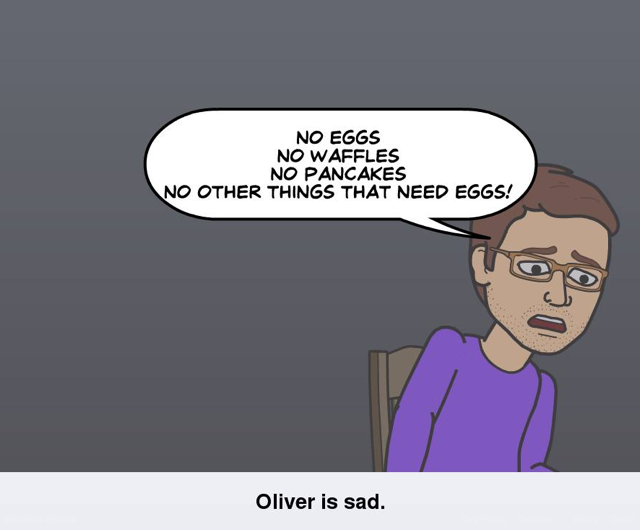
Waffleless, I returned, nonetheless, to the snow and ice battle.
I made a little more headway on Sunday afternoon on both the back and front, but we were already starting to see some water in our front and back second-floor bedrooms – not great torrents, but enough to be worrisome – and so we concluded that it was time to return to the task of finding professionals.
Catherine made another round of calls, and managed to find a couple of teams that could at least come and “take a look” on Monday morning.
And then our PEI Mutual Insurance claims man made a courtesy call – we’re not covered for ice dam damage under our home insurance policy, but we’d called anyway and he offered to drop by. It was, he told us, one of a number of similar calls over the weekend, and we took some solace in the fact that we weren’t the worst house he’d seen that day. He made a few recommendations for additional help – Ford’s Mobile Wash might be able to steam the gutters, for example – and went off into the night.
Mehrnoosh Saves the Day
At this point I reached out to my friend Mehrnoosh, who’s much more plugged into the Charlottetown-area trades than we are, to see if anyone he knew might help us out.
He immediately sprang into action and by Monday morning at the crack of dawn he had a crew of pros lined up and due to arrive at the house at 9:30. Which they did.
And they sprang to work.
On the front, they started with this:

and, midway through the job, it looked like this:

And by mid-afternoon, our back roof was in much better shape too:

It’s hard to get a sense from that photo of just how dramatic an improvement that was from the situation they started with, but here’s what the mound of snow and ice they removed – or at least part of it – looked like on the ground:

In the end they were on the roof from about 9:30 a.m. to 1:30 p.m. with two teams, one on the back and one on the front. Both sides are clear of snow now, and they axed out a large part of the ice dam too.
Pantyhose Redux
Did the This Old House technique with ice-melter-filled pantyhose actually do any good?
It’s hard to tell. There was certainly some ice-melting that resulted, but when I compare the amount of effort needed to buy and haul the bags of ice melter, to assemble the melter-filled pantyhose legs, and to get them up on the roof, it wasn’t worth the effort: they made a tiny dent in a problem that needed a substantial solution – removing all the ice and the snow that was driving the ice. We might have received an few hours of water infiltration freedom by redirecting some of the water, but I was only able reach about 1/10th of the gutter surface, and to fully implement this solution would have required 10x more ice melter, 10x more pantyhose, and a lot more ladder dexterity.
So it’s not an exercise we’re likely to repeat.
Where to from here?
With more snow coming later this week – and winter not over, practically speaking, until April? May? – we’re at least better-equipped to deal with the situation now: I can clear the snow with the monster roof rake after every storm and, touch wood, that should be enough to keep new ice dams from forming.
Once winter’s over, this will be the summer that we address the larger issue, perhaps raising and changing the pitch of the back roof, getting a new roof on the entire house with a water barrier, and adding insulation and venting where it needs to go.
Section 2.1 of the City of Charlottetown Dog Control Bylaw says:
Any dog owner residing in the City who does not register a dog with the Clerk on or before the 31st day of March in each year, and does not pay a license fee as set out in Schedule “A” annexed to this Bylaw, is guilty of an offence.
We picked up our 2015 dog tag for Ethan this morning, well in advance of the March 31st deadline, and Ethan was assigned dog tag number 007, which suggests that there are a lot of dogs remaining unregistered this year.
Oliver is iffy on whether Ethan will be allowed to leave his side to attend to his MI-6 duties.

After the week of heavy snow we’ve had here on Prince Edward Island, I wanted to search IslandNewspapers.ca for references to “snow storm” that appeared in The Guardian newspaper.
Entering “snow storm” as a search term produced 1,434 results, and many of these were references in articles deep inside the paper, like this one from page 4 of the January 30, 1952 paper:
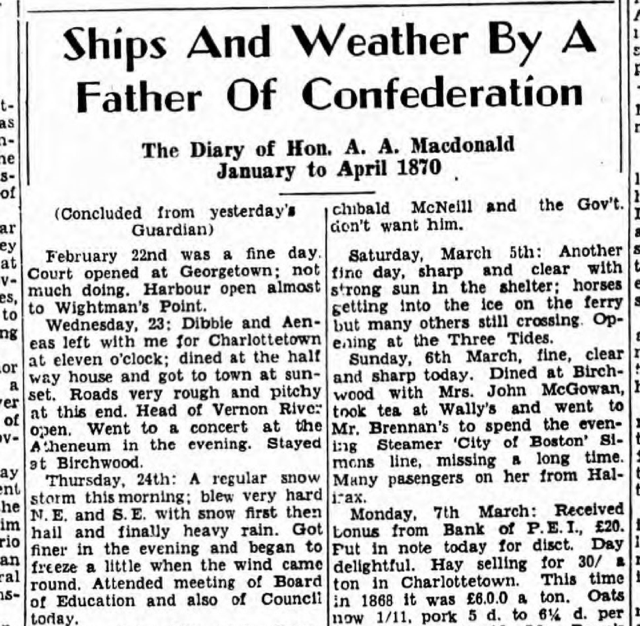
An interesting story, no doubt, but what I really wanted was “front page news” blizzards. News likely to be contemporary and local rather than reports from the bygone days.
But there wasn’t a way to limit my search by page number.
So I asked Don Moses, who manages the project, and his quick reply – on a snow day, no less – was:
We do index the page number of the page. I’ve added a facet “Page Number” to the search results page. So if you do your search … you’ll see the facet for page at the bottom of the facets listed and can apply that as a limit.
And, sure enough, repeating the search now shows this handy facet in the right-hand sidebar:

By clicking on “1”, I can limit my search to the 322 occurences of “snow storm” that appeared on the front page of the paper.
And by further filtering my search by clicking on “February” under the “Month” facet, I can see only the 64 front-pages containing keywords “snow storm” that ran during that month.
Like this story, with photo, reporting on the crash of a BOAC airplane at Charlottetown Airport during a snow storm on February 25. 1946 :
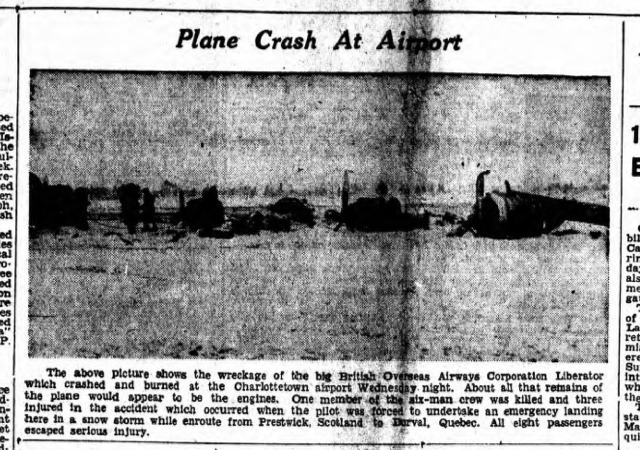
And this story about 15 inches of snow falling over two days from February 8, 1956:
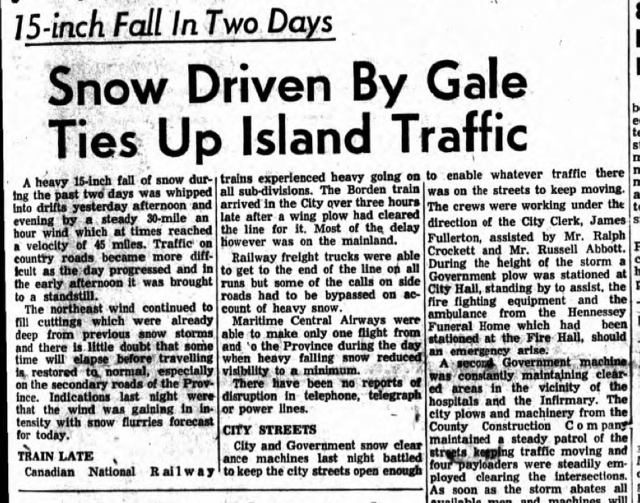
And the cover of the February 10, 1948 edition, reporting on several snow-related incidents, including the death of a Skinner’s Pond man:

And this bracing story from February 22, 1932 reporting on a train collision near Tignish that happened in “blinding snow storm and zero weather”:
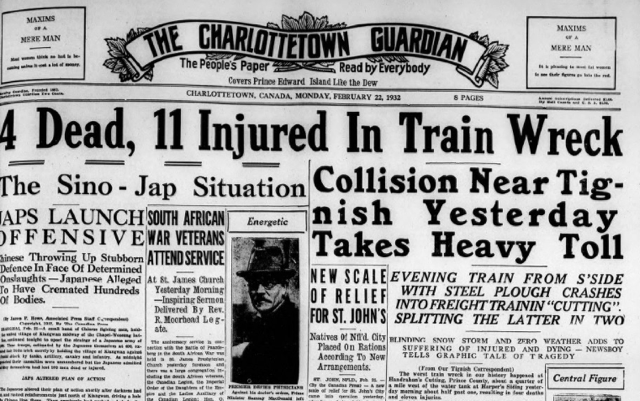
This new ability to filter by page number is a terrific addition to IslandNewspapers.ca, and that Don was able to quickly implement it is a testament to the flexibility of the Islandora platform.
Wikipedia tells us that the surface area of Prince Edward Island is 5,660 km2.
The square root of 5,660 is 75.23, meaning that, if reconfigured to be a square, PEI would be 75.23 km by 75.23 km.
NASA tells us that “freshly-fallen snow has a density of 50 kg/m3.”
One centimeter of freshly-fallen snow on a 75.23 km by 75.23 km box is a cube that’s 7,523,000 cm by 7,523,000 cm by 1 cm.
That’s a cube that’s 56,595,529,000,000 cm3 or 56,595,529 m3.
At 50 kg/m3 that means that a one centimeter snowfall on Prince Edward Island has a mass of 2,829,776,450 kg, which is 2,829,776.45 metric tons.
So an 86 cm fall of snow has a mass of 226,382,116 metric tons.
Dump trucks vary, but it seems their capacity is around 32 metric tons, so that’s about 7 million dump trucks worth of snow.
Is my math correct?
Posting this here just in case others find themselves in the same situation.
Since migrating this site from my own silverorange-colocated server to Amazon AWS, I’ve been experiencing seemingly random Apache server outages. The usual suspects – mismatched Apache and MySQL settings, lack of memory, etc. – didn’t seem to apply, and the symptoms were confoundingly simple: all of Apache’s processes – up to the MaxClients settings limit – would be “hung,” and the server would be unreachable. But MySQL was fine, the system load was fine, and, as near as I could tell, everything was beautiful and sunny. Except that Apache was, effectively, hung.
After several weeks of Googling away for “Apache hung processes” and “Apache process limit” and “Apache crashed” and “mysterious and confounding Apache issue,” I launched into some more serious Apache debugging and eventually traced the issue to some variation of APC and this PHP issue. The debugging that got me there was running strace on any of the child Apache processes and seeing:
futex(0x2b19a0b01070, FUTEX_WAIT, 2, NULL)
Rather than trying to solve the APC issue itself, I solved the issue – fingers cross – by upgrading from Apache 2.2 to Apache 2.4 and from PHP 5.3.29 to PHP 5.5.20. Among other things, this let me jettison APC and use PHP OPcache instead. Which appears to have addressed the larger issue, and given me access to a nice OPcache visualization to boot:

It snowed. For two days. 86 cm worth of snow in Charlottetown at last report.
And then it was over. Today is a bright, sunny day. Schools are closed. Businesses are closed. There is a lot of snow. Everywhere.
However, by some miracle, the sidewalk plow passed in front of our house early this morning.
And our resourceful neighbour flagged down a snow-thrower-equipped tractor yesterday and paid him to blow out our driveway.
And the walk from home to office, although without sidewalks, is passable. And Receiver Coffee is open. And the side door of the Reinventorium was free of snow.
It’s almost as if the storm never happened.
I may be unique in this viewpoint.
So yesterday I gave my Jetta the day off, in the humid and warm confines of the Delta Prince Edward underground parking lot.
Around supper time I retrieved the car and returning it to the frigid temperatures of the Charlottetown night. I drove home, parked for a few minutes, then drove across the Hillsborough River to Stratford for a couple of hours, then headed back home.
I noticed, while heading across the bridge the first time, an unusual high-pitched whine from the engine, and also noticed that my headlights didn’t appear as bright as they usually do. On the way back home I pulled into the Riverside Irving to clear my windows and when I tried to start the car back up it refused to start, showing classic signs of a dead battery.
I rang up brother Johnny and he heroically hopped in his car and came to my rescue; by the time he arrived I’d managed to start the Jetta back up, but it continued to act strangely.
And so I decided the best course of action was to hobble over to Dave’s Service Centre – you remember Dave’s, right? – and found, to my surprise and delight, that Dave himself was still in the shop. We had a chat and he deduced that it was likely an alternator failure at the root of the issue: the car had been running on battery alone, which was why it refused to start and why the lights were dim.
So I left the car with Dave, and am waiting to hear back this morning.
Moral of the story? Never give your car the day off.
After a slow start, the snow has come to Charlottetown in droves over the past several weeks. By some miracle, we’ve managed to keep our car shoveled out and driveable, in no small part due to the generosity of mysterious forces that have conspired to blow out the space between the road and the sidewalk that gets packed tight with snow from the plows (whoever you are: thank you).

Our car – now 15 years old – still starts on all but the coldest of cold mornings. But in the last storm the wind snow and rain and temperature combined to deposit solid blocks of ice in the space in front of the front doors, meaning they don’t open completely and thus require the driver to execute a complex limbo-like manoeuvre to enter the car.
To solve this issue, at least for now, I’ve given the car a day off: after running Oliver to school and Catherine to an appointment, I drove down to the Delta Prince Edward and left the car in the underground heated garage for the day. The Jetta breathed a satisfying sigh of relief as soon as it was hit by the warm underground air: I’m looking forward to returning in 8 hours time to pick up a refreshed car with openable doors.
Podcasting, it seems, is undergoing a renaissance. And my favourite of the new crop is Invisibilia from NPR, a podcast (and, apparently, also a radio program) that “explores the intangible forces that shape human behavior.”
They are four episodes in now, and I’ve been fascinated by something – and usually more than one something – on every episode I’ve listened to.
Their description of the three schools of psychotherapy – who knew! – in The Secret History of Thoughts and the part of the Entanglement episode discussing how distant atoms can somehow at once be the same atom, are the highlights for me so far.
I encourage you to listen.
My podcast-listening application of choice (thank goodness “podcatcher” never took off as a noun) is Pocket Casts, which is available for both iOS and Android and here’s what you’ll find in my subscription list these days (the links are the podcast subscription links that you can add to your, er, podcatcher):
- Planet Money - also from NPR, I enjoy their approach to money and the economy; it’s a sweet spot between lowbrow and highbrow.
- 99% Invisible - design, architecture, curiousities.
- Transom - seldom updated, but the back catalogue of independent documentaries is rock-solid.
- Invisibilia - as above!
- CANADALAND - hyperbolic, but interesting nonetheless.
- Slate’s Working - where did it go? I hope it returns, as each episode’s focus on the quotidian aspects of a different profession was gripping.
- Reply All - technology with a humanist bent.
- Radiolab - arguable the grandfather of Invisibilia, and a pioneering user of what might be called “cinematic” techniques in radio.
- Longform - a collection of interviews with writers about the craft (sort of like “Working,” but broader in scope but limited to a single profession).
- Mark Kermode and Simon Mayo’s Film Reviews - I can’t imagine going anywhere else for film reviews; my longest-standing subscription.
- StartUp - a podcast about starting a podcasting company; I love it.
- TravelCommons - much less regular in recent years, but I keep listening because of the focus on the quotidian aspects of business travel.
- This American Life - the classic.
It appears, as I write those thumbnails, that “quotidian” is my passion of choice.
Here’s an OPML file of all of the above that you can import into your podcast-listener if you want to slurp them all into your life too.
I have found myself in possession of a letterpress cut of former Prince Edward Island Premier Alex B. Campbell’s signature.
While I thought briefly that I might use this great power dash off some quick orders in council for planting in the provincial archives, I thought better of this, and decided instead to set a passage from one of his speeches, one quoted in Alex B. Campbell: The Premier that Rocked the Cradle that was delivered at the Canadian National Exhibition in 1967.
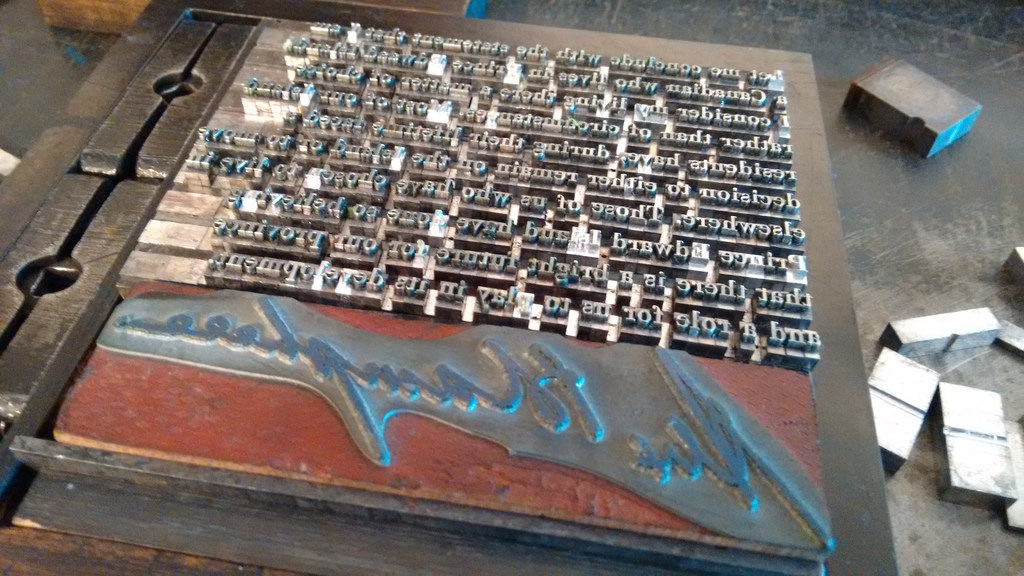
I’m debating justifying the text; I’m generally more of a ragged-right person, but perhaps it would suit in this instance.

 I am
I am